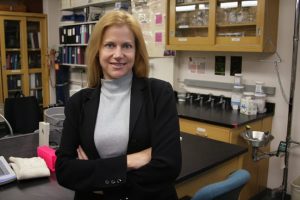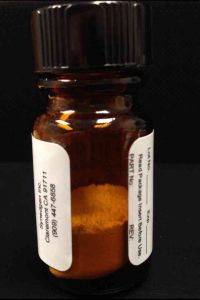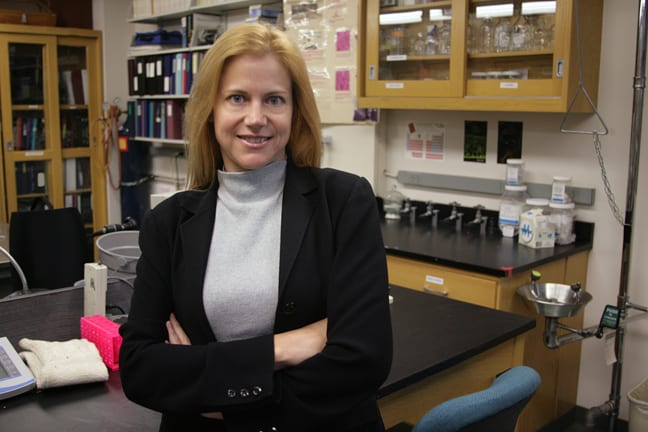Soft polymeric materials can easily conform to and be made compatible with living tissues, and have thus great potential for biomedical applications.
Our interview series on materials scientists turned entrepreneurs continues with Shenda Baker, a professor at Harvey Mudd College on leave who is currently full-time at Synedgen, a startup striving to commercialize polymers for healthcare. Shenda is also at present on the Board of Directors of the Materials Research Society.
1) Can you give me a brief pitch about what the main product of your company (Synedgen) is, and what is its purpose?
Synedgen is an innovative pharmaceutical company that modifies natural polysaccharides to control and modulate inflammation, tissue regeneration and infection. We have a great, but small, team of scientists and consultants who are committed to the success of Synedgen.
Using polymer chemistry and physics, we have designed molecules that disrupt mucus (for patients who have chronic build up of mucus in their lungs due to a genetic defect) or that break up bacterial biofilms that cause chronic, non-healing wounds and infections. As a biomimetic, we can design the polymer to act like defensins and antimicrobial peptides, molecules produced by our cells to control inflammation and infection.We use a natural biopolymer and modify its properties to target areas of the body or therapeutic targets in the skin, oral cavity, gastrointestinal tract, lungs and eyes.
No polymeric drugs have been approved by the FDA (Food and Drug Administration) except for protein biologics (Editor’s note: biologics are defined as being created by biological processes, rather than chemical synthesis), peptides, or vaccines, and the FDA has declared that our polysaccharides are not “biologics”. Therefore, our polymers will be treated as small molecule drugs, which will be a challenge. Yet they will provide a completely new approach to mitigating infections and reducing inflammation.
2) What is your role within the company? How different do you feel that the role you play within Synedgen is, with respect to having the same job at a large, established company?
I am President, Chief Operating Officer, and co-founder of Synedgen. In a start-up, the role of President (or CEO) is less defined than, and not as well financially supported as, in a large established company for all the reasons that one knows about wearing all hats. Funds are tight, travel is limited (particularly on government grants), and weekends, holidays, and nights belong to ensuring that the company survives. However, in addition to raising funds and thinking about the big picture goals and implications, I have direct, daily access to and input into the science, the business development, the manufacturing, regulatory process… it is an incredible learning experience.
3) When did you figure out that there was a good opportunity for commercial exploitation of this discovery/material?
We started exploring the properties of these modified biopolymers and found that they exceeded our expectations. In 2007, my sabbatical focused on better syntheses and better control of the polymer product we had invented in 2004. The in vitro studies were excellent, but our preliminary animal studies, the first in 2006, were outstanding. In 2009, I took a leave of absence from Harvey Mudd College to help push Synedgen to the next phase. By 2009, it was clear that the potential for the suite of polymer drugs we had created could have a dramatic impact on human health. It has been an exciting roller coaster of discovery, process and fundraising ever since.
4) How long was the process from the “idea” to the creation of the company? Can you give me a detailed breakdown (R&D, IP protection, setting up the company…)?
The idea came across a cocktail napkin (literally) in 2004, and two founders (Dr. William Wiesmann and me) were writing patents in late 2005. Patents are an important ongoing investment. In 2006 we had set up a small space in southern California and worked with our partner manufacturing company until 2009, when we merged to become Synedgen. Our animal and ex vivo data is compelling and we do not need to invest much more in non-human demonstration for our first products. Thus, if we can raise the funds we need to cross the pharmaceutical valley of death (the safety pharmacology and toxicology studies), we could be in human trials by 2014. So, 10 years from invention to first in humans. Our rate of progress is very much dependent on how quickly we can bring in funds.
5) Where did you turn for funding? If you used venture capital, was it difficult to get funded outside the “traditional” geographical locations of venture capital firms?
We have been very fortunate to have primarily government funding supplemented by “friends and family” investments. About 90% of our funding so far is from the Army, DARPA and NIH. It is imperative to have private, unrestricted funding in a small company to pay for corporate lawyers, taxes, IP, etc., use of funds that the government strictly prohibits. We have been blessed by a small group of shareholders that understands our product, and by great animal data that makes the grant proposal writing easier. At this point, we have two products that are not human drug products that could generate some revenue, but we will need to be creative to get to the human drug products. Our mission now is to find strategic partners who will work with us to bring this new class of drug products to market. We are eager to transition to a self-sufficient company through products and partnerships.
 6) Before starting this venture, did you want to become an entrepreneur?
6) Before starting this venture, did you want to become an entrepreneur?
I have always loved innovation and the idea that what I developed in the laboratory could have real application. But I never consciously sought to be anything other than a professor. The transition to an entrepreneur was a relatively slow evolution. The potential of inventing and making a product that could mitigate human suffering and save lives is pretty compelling –to see it as a potential actuality in my lifetime rather than a downstream consequence was sufficient to pull me away.
7) What is the main change in mindset that this venture brought to you? What is the most important thing you could not have possibly understood had you not started your own company?
I had no conception about either the pharmaceutical industry or the tremendously volatile nature of a small business, from my academic perspective. Of course, we have all heard about the ~1 in 10 success rate of small start-up companies, but the multitude of reasons that a good company with good ideas fails is astonishing. I could not have possibly understood the hurdles and costs involved in keeping a good idea protected with IP, demonstrating efficacy in multiple (accepted) animal models, manufacturing under the constraints of current Good Manufacturing Processes, wading through the FDA regulatory process, adapting the good idea into something that will be accepted by those who make funding and regulatory decisions. It is easy to envision how a significant breakthrough could change how we treat infections and tissue inflammation; it is another thing altogether to truly understand how to get that product to the human healthcare market.
8) Why did you decide to dedicate yourself full time to the company, as opposed to remaining an academic scientist and working on the company “on the side”/consulting/…?
This is a question I often ask myself! However, I had the right skill set and an excellent mentor to understand the science from multiple perspectives, do strategic planning and manage the growing team. Most importantly for me, we keep discovering different properties of this set of molecules that mimic very complicated and ancient biological systems. Much of my job is very much like an academic research environment, and the science is compelling. I do a lot of teaching as every proposal, presentation and briefing is centered on bringing the audience to understanding the uniqueness of our approach as well as its centrality in biological responses. The transition took 3-4 years before I was fully committed to the company. But it became fully engrossing.
9) Do you still work on scientific projects unrelated to the company, but linked to your previous academic career? (And/or what do you miss about academia, if anything)
I enjoy collaborating with academic partners, and am maintaining some of those relationships (I hope) and perhaps developing some new ones by actively participating on the Board of Directors of the Materials Research Society. I miss the slower pace of academia and the regular structure of the year, but I miss students the most. Still, I get to overlap my academic and industrial lives a little more as we work regularly with academic collaborators and we are seeking researchers to help model one of the hypothetical interactions of our molecule –a polyionic, entropically driven displacement system that should be a lot of fun to map into the data we observe. Still, the creation of structure and new relationships built around the ever changing process in getting our products closer to human trials motivates me in new ways I had not experienced in my academic career.
10) How do you juggle your time among the different needs of the company (necessity to develop the product on one side, and to raise funds/look for customers on the other)?
In a small start-up, it is quite the juggling show, and the rule of many hats is not overstated, not just for me but for all of our dedicated staff. Not surprisingly, days are very long in the office, on the road and on the phone, particularly because we have collaborators around the world from Boston to Japan to Dublin. As President of Synedgen, the best balance I can do is to recognize what skills I have that are not reproduced in the company, focus there, and allocate often.
11) Do you still publish in the open scientific literature, and what value do you think scientific publishing has for a scientist in industry or for a startup?
Synedgen has just begun to publish actively, and it is a very important and validating process for a startup. We had to get all of our patents and even subsequent patents submitted before having the confidence to publish. With the new US rules regarding not first to invent, but first to patent, there is even more concern about holding ideas close until the original concept as well as potential spin off and secondary concepts can also be patented. However, if a startup is funded primarily through government grants including NIH, then publications generate tremendous validating credibility. Patents are not peer reviewed, and thus to some panels and grant reviewers, are only suggestive of useful science. For us, it’s a tough balance because we would like to publish more, but get nervous when we actually think about the details that we would publish.

















